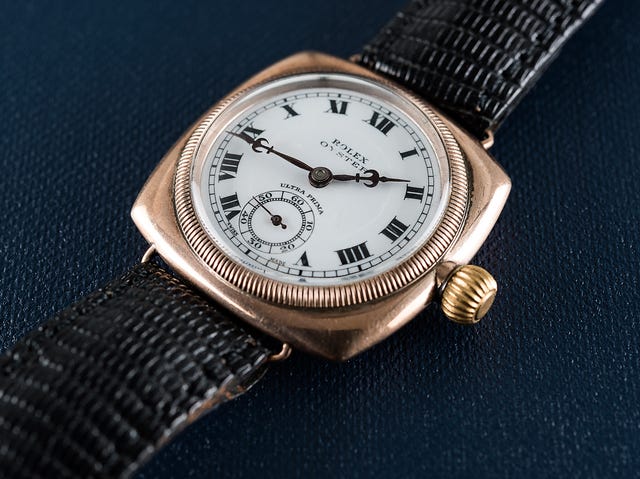
Christopher Beccan
The watch that changed everything: the 90th anniversary of the Rolex Oyster
A unique 90-year-old Rolex gives us cause to look back at the invention that cemented not just the reputation of watchmaking’s most famous house, but the very viability of the wristwatch itself.
Rolex did something truly astonishing in 1927: it released a genuinely waterproof wristwatch that, unlike earlier efforts from other firms, neither looked nor felt unusual, and could be worn on a daily basis. The seasoned Rolex enthusiast may well recognise the model above as an early example of that historic game-changer: a first generation Rolex Oyster.
That would make it 89 years old. But its markings tell us that it is, in fact, one year older than that. While the first models dodate from 1927 – famously, the English swimmer Mercedes Gleitze was given one to wear as she swum across the Channel that October – it was in 1926 that the Oyster was conceived and prototyped; and indeed, the one pictured here is just such a 90-year-old prototype. On such an anniversary, the details of how and why the Oyster came to be are worth examining.
Hans Wilsdorf, the founder of Rolex, was never a watchmaker. In all his legal documents he gave his profession as “merchant” – someone who buys and sells. This is important to understand, because for the five decades and more that he ran the firm, Rolex didn’t make watches from scratch as it does now; rather, it assembled them. Movements were bought from one firm and cases from another, as were dials, bracelets and all the other components. Rolex was able to take commonly made items and assemble them into something special, thanks in particular to Wilsdorf’s talent for spotting a hole in the market. Nowadays we would call him a marketing genius, and nothing exemplifies this skill more than the story of the Rolex Oyster.
The trench warfare of WWI had demonstrated the advantages of the wristwatch over the pocket watch, and Rolex had been one of the first watch manufacturers to capitalise on this shift. But in the following years civilian users of wristwatches had two complaints: they weren’t as accurate as their pocket watches of old, and they had a tendency to need servicing much more often than pocket watches, since the oils got clogged with dust and detritus or the movements succumbed to water ingress.
The first problem could be expected, since smaller movements meant smaller balance wheels. Wilsdorf attempted to overcome buyers’ prejudice by submitting many of his watches for testing at both Swiss and Kew laboratories to prove their accuracy. That continues to this day, of course, with Rolex being by far the largest producer of COSC-certified chronometers.
The second problem, of dust and water invading the mechanism, was much more difficult to solve, although many had tried. In the Victorian era, for instance, pocket watches used by explorers were fitted with a screw-down cap over the winding crown, attached to the body of the watch by a small chain – a clumsy system that necessitated a very tiny winding crown to fit under the screw cap. (This design was reintroduced, incidentally, by Cartier in the 1990s with the Pasha).
The first attempts at making a water-resistant wristwatch came with “hermetic” cased watches from the early 1920s. Here, the watch was completely encased in a second outer case, and could be wound and set by unscrewing the bezel and flipping the watch out on its hinge. This design had two major problems, due to the use of gold or silver for the cases. Both being very soft metals, the daily unscrewing of the bezel caused the screw threads and bezel knurling to wear out, the former meaning that the watch was no longer waterproof and the latter meaning it became difficult to unscrew the bezel anyway.
An astute reader will have noticed that both of these early attempts focussed on protecting the crown, this being the most obvious entry point for unwanted substances. What was needed was a method of securing the crown and making it waterproof itself, and in May 1926 fate intervened
.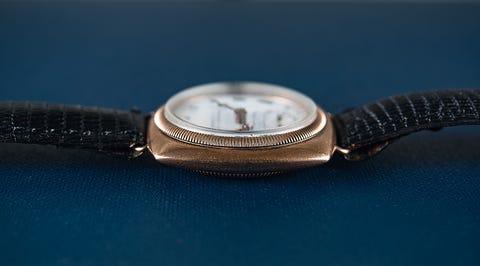

Wilsdorf would have made it a habit to scour the entries in the Swiss patent register for anything he thought that he could use, and patent 114948 certainly fitted that description. It was filed by two gentlemen from La Chaux-de-Fonds, Paul Perregaux and Georges Peret, and proposed a system for a winding crown that screwed down on to a threaded tube protruding from the case. As the crown was in the normal position and unencumbered by a cap or an extra case, it was much easier to use and therefore much more likely to achieve sales success; Wilsdorf lost no time in acquiring the patent from its owners, and within months the Rolex Oyster was on the market.
Or so the accepted history has it, though recent research refines the story. In a 2010 article in the US National Association of Watch & Clock Collectors (NAWCC) Bulletin, watch historian David Boettcher showed that the patent was in fact transferred to one Charles Rodolphe Spillmann, who owned a casemaking firm in La Chaux-de-Fonds, on July 19, 1926. Then, five days later, it was transferred from Spillmann to Wilsdorf himself – interestingly, not to Rolex directly. After a further five days, on July 29, Mr. Wilsdorf registered the trademark “Oyster” and the package was complete: case, crown and name were all in place.
I believe Spillmann was much more than an intermediary used by Wilsdorf to conceal his interest in the patent. I think Spillmann brought the Perregaux/Perret patent to Wilsdorf himself, and explained to him how combining this crown with a waterproof case he had recently invented could make the world’s first waterproof watch. While I have no proof for this theory, if you look at the image of the inside caseback on the 1926 Oyster prototype pictured, you will see a small hammer head at the bottom. This is a Swiss casemaker’s stamp, and inside it is the number 136, which indicates that the case was made by C. R. Spillmann & Cie of La Chaux-de-Fonds. This mark can be found inside almost all early gold Rolex Oyster cases, indicating that Spillmann’s firm alone was responsible for all of them.
The design of the original Oyster case itself is quite interesting, as the movement is not attached directly to the case body. Rather, the case is composed of three parts: a central case with the lugs attached to it, and separate bezel and case-back, both screw-on. The movement, dial and hands are held in a metal ring with external screwed threads, with a hole at the 3 o’clock position and a pin at the 9 o’clock position. The ring is inserted into the case body, and the pin at 9 fits into a matching hole in the case; the crown and winding stem are then fitted into the hole at 3 and the bezel and case back are screwed into place.
At this time Rolex made much in its advertising about using no cork or leather washers in its watches, stating that it only used metal to metal contact; this was true but it did use a washer inside the caseback, in order to ensure a perfect seal. However, this was made from a thin sheet of lead, which deformed when screwed down to allow for any irregularities in the machining of the caseback surfaces.
The shape of the case is known as a “cushion” and was used by Rolex and others from the second decade of the century, and Rolex itself continued to make use of it until the end of WWII. The Oyster was also launched in an alternative case style, the Octagon, which was never as popular as the Cushion and which lasted less than a decade in the firm’s catalogue; most likely because it was seen as looking old-fashioned even then.
As with all Rolex watches of the period, the movements were made by Aegler in Bienne, and this particular movement was known as the 10½ Hunter: 10½ being the size in lignes (23.7mm) and “Hunter” being the layout of the watch design, meaning that the winding crown was at 3, as in a hunter pocket watch (one with a lid that closed over the dial), rather than at 12 as in an open-face pocket watch.
The movements came in three versions: Prima, Extra Prima and Ultra Prima. They are all 15 jewel constructions, and differentiated only by the timing tests carried out after construction: the best 10 per cent were given the coveted Ultra Prima designation, while the balance were split between Prima, which were the less accurate and Extra Prima, which fell in between. The Ultra Prima watches were also usually marked as such on the dial, as can be seen in this case.
In the mid-1930s Rolex moved from the complex three-part Oyster case to a simpler two piece design which integrated the bezel into the case body and did away with the movement holder, and Spillmann seems to have vanished from the Oyster story – but not, in fact, permanently. In the 1960s the initials “C.R.S.” are to be seen inside the casebacks of Rolex chronographs, and this relationship continued for almost two decades. Neither was it the end of the cushion case, of course: in the late 1930s Rolex produced an oversized version of this case for an obscure Italian instrument maker, Officine Panerai. The rest, on that front at least, is the stuff of watchmaking legend.
So it is for Rolex too. Despite external changes as watches grew larger during the late 1940s, the essential design of the Oyster case remained pretty constant until the early 1950s, when (as with the introduction of the original Oyster) a new case and crown came along together. The crown was called the Twinlock, and as you can probably guess used two gaskets to ensure it was watertight – initially guaranteed waterproof down to 50m, it was a genuine breakthrough in making watchcases impermeable.
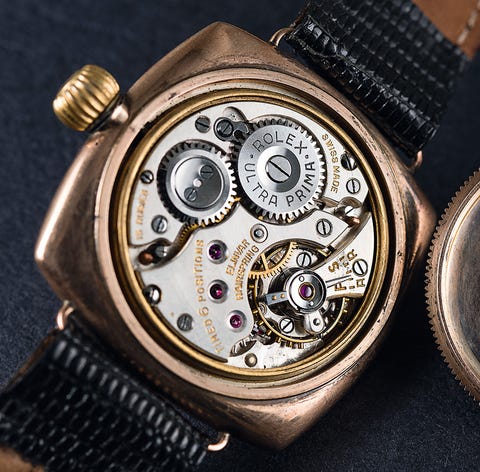
Christopher Beccan
In 1953 Rolex also introduced a heavier two-piece case, but with the provision for a rotating bezel; the first to use it was the reference 6202 Turn-O-Graph, which had a bezel insert marked with 60-minute markers. Marketed as a waterproof alternative to a chronograph, it wasn’t a commercial success; but it became the basis for one of the most iconic watches ever made by Rolex, the Submariner. That launched the following spring at the Basel Fair, following Swiss explorer Jacques Piccard’s historic bathyscaphe dive with a specially built Rolex attached to his submersible.
Over the years, the parallel development of cases and crowns has continued, via the Sea Dweller in the 1960s and the Deepsea in 2008. For the latter, Rolex abandoned the 60-year history of the two-piece case and reverted to the original Oyster design with a separate movement ring inside the main case body. It proves that a now 90–year-old design is capable of 21st century performance; and also that, sometimes, going forward can mean going back to your starting point.
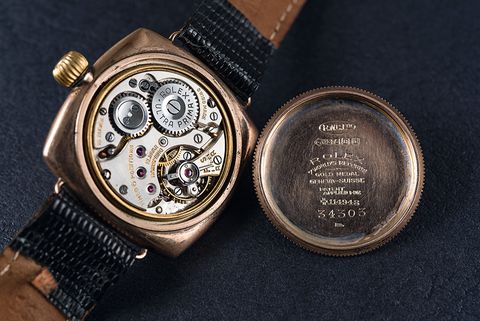

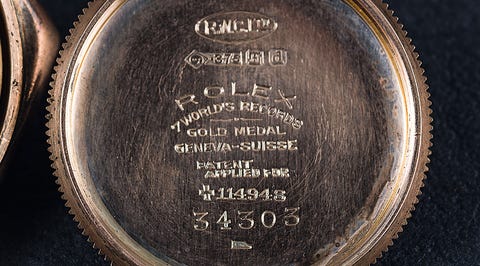


No comments:
Post a Comment